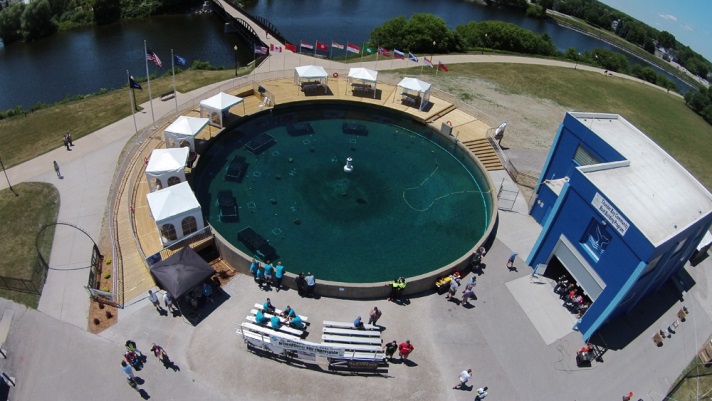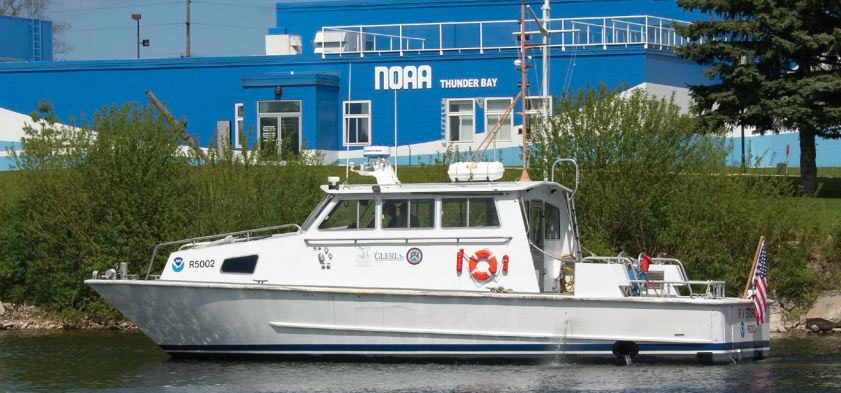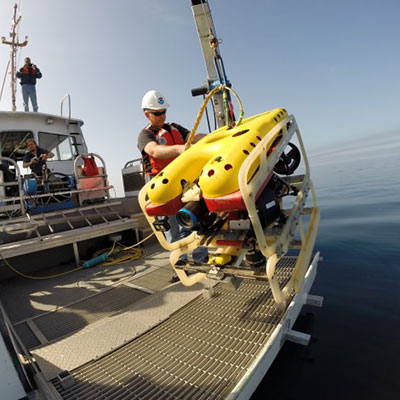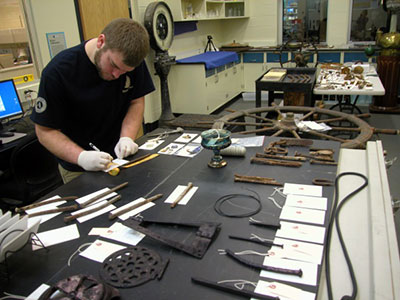Facilitating Science
Thunder Bay

There are several resources available to researchers at Thunder Bay National Marine Sanctuary. Please contact the Research Coordinator for discussions on facilitating research within the Thunder Bay Sanctuary.
Research Coordinator: Stephanie Gandulla
Boats
Thunder Bay National Marine Sancuary operates the 50-foot RV Storm and a 26-foot Boston Whaler. These vessles support research, monitoring, and education within the sanctuary. Please contact the research coordinator for more information on collaborative research aboard sanctuary vessels.

Permits
Thunder Bay National Marine Sanctuary regulations provide for temporary permitting of specific activities that are not otherwise permissible. Such activities are reviewed on a case-by-case basis. Permit requests are evaluated based on their potential single and cumulative impacts to sanctuary resources versus the potential benefits the activity may provide in terms of resource protection. Permitted activities are typically research oriented and are reviewed in cooperation with the State of Michigan. A permit is required to conduct research within Thunder Bay National Marine Sanctuary. Learn more about permitting and regulations in the sanctuary.
Refer to our Frequently Asked Questions to help determine if a permit is required for your proposed activity. Guidance on how to apply for a sanctuary permit can be found on this page.
Diving

Diving is a fundamental tool for sanctuary archeologists. Although sanctuary regulations pertain only to maritime archaeological resources, the sanctuary is dedicated to facilitating scientific research and monitoring that improves our understanding of Lake Huron's natural resources. Beyond data sharing, such as bathymetry maps produced during sanctuary remote sensing operations, the sanctuary regularly provides scientific diving, research vessel, housing, lab support and workspace for a variety of multidisciplinary projects. Ongoing projects for which the sanctuary conducts scientific diving ion behalf of outside research teams include the Middle island Sinkhole and Thunder Bay Reef Restoration projects.
Additionally, the sanctuary relies heavily on the work of others to help respond to pressures on its resources. Many groups and individuals impart energy, expertise, and equipment critical to sanctuary resource protection. Leveraging these partnerships is critical to the sanctuary's successful and sustained management of its resources. Still other partners have their own research objectives, aimed at both cultural and natural resources, and the sanctuary actively supports these efforts.
Lab Space

The sanctuary operates an artifact conservation lab that can also provide researchers with a clean, secure place to process biological samples. Among other amenities, the lab has a fume hood, sinks, refrigerator/freezer, and safety equipment. Additionally, the sanctuary has warehouse and workshop space that can be used to store and assemble equipment.
Accommodations
The sanctuary has on-site housing for up to 10 researchers. The 3 bedroom facility includes a full kitchen, washer/dryer and Wi-Fi. The sanctuary has housed a wide range of researchers, from graduate level field schools to interns to independent scholars. A research partner's presence in Alpena also has an important effect on the local economy, further strengthening the sanctuary's tie to the community. In 2011, 98 individuals spent 278 overnight stays in the Alpena area in support of sanctuary-related work.
Research Areas
There are no special areas that need researchers need to be aware of as they develop research plans. Researchers should, however, be familiar with the various regulations in place at Thunder Bay National Marine Sanctuary.
Data Buoys
A network of buoys that collect real-time data on oceanic conditions have been deployed in and near Thunder Bay National Marine Sanctuary. Collected parameters include wind speed and direction, wave height, dominant wave period, average wave period, air temperature, water temperature and atmospheric pressure. A listing of these buoys may be accessed from here. NOAA's Great Lakes Environmental Research Lab maintains several webcam and real-time weather stations throughout the Great Lakes.
Equipment and Instruments
The Center of Excellence for Diving and Marine Technology Education at Thunder Bay National Marine Sanctuary (TBNMS) is a controlled environment for research and technology applications, educational programs, outreach events, and drills and trainings. It has three interrelated goals:
-
To become a hub for specialized dive training and innovation, serving partners within NOAA, the broader science community, and state and regional public safety agencies;
-
To export diving expertise and capabilities that will enhance conservation efforts throughout the National Marine Sanctuary System, NOAA and the broader science community; and
-
To establish a Great Lakes hub for applied marine technology education, offering teachers and students from elementary school through higher education a stimulating environment to develop projects, train and supplement their own curriculum.
The Center of Excellence has first-class facilities, equipment and platforms on the TBNMS campus in Alpena, MI, and nearby access to other areas and equipment to support expert diving operations.
-
Training Tank: 550,000 gallon (80 ft wide x 14 ft deep); freshwater; concrete; decking around half; wheelchair accessible; multiple power drops at side.
-
Open Water: Moorings at 25 shipwreck sites (8 ft to 100 ft); access to beach and river dive sites; excellent confined water training areas.
-
Research Vessel Storm: 50 ft; twin 500 hp diesel engines; capacity for 8 divers; 300 nm range; onboard emergency oxygen system; 2000 lbs crane; multi-beam and side scan sonars; two remotely operated vehicles; dropdown transom and through hull diver recall system.
-
Equipment: 700 sq ft, climate-controlled dive locker; compressors, gas boosters and related equipment for air, nitrox and mixed-gas diving; access to two mono-place recompression chambers; access to indoor pool.
-
Other Capabilities: Full open-circuit and closed-circuit rebreather mixed-gas diving capabilities to 250 ft.
-
Meeting and Housing Facilities: Space to host 20 divers for training; housing for 10 people; 50-seat classroom; 100-seat theater with video conferencing.
Special Considerations
There are no special considerations that researchers need to be aware of at Thunder Bay National Marine Sanctuary.
Key Documents
Sanctuary staff can assist with helping researchers find background information and current research on their particular topic/interest. For historical research, the Thunder Bay Sanctuary Research Collection is a great place to start. There are also a number of other archival collections throughout the Great Lakes.
Research Needs
Documents that describe the immediate science needs for critical management issues.
Condition Report
The Condition Report is a summary of the status and trend of sanctuary resources, pressures on those resources, and management responses to the pressures that threaten the marine environment.

